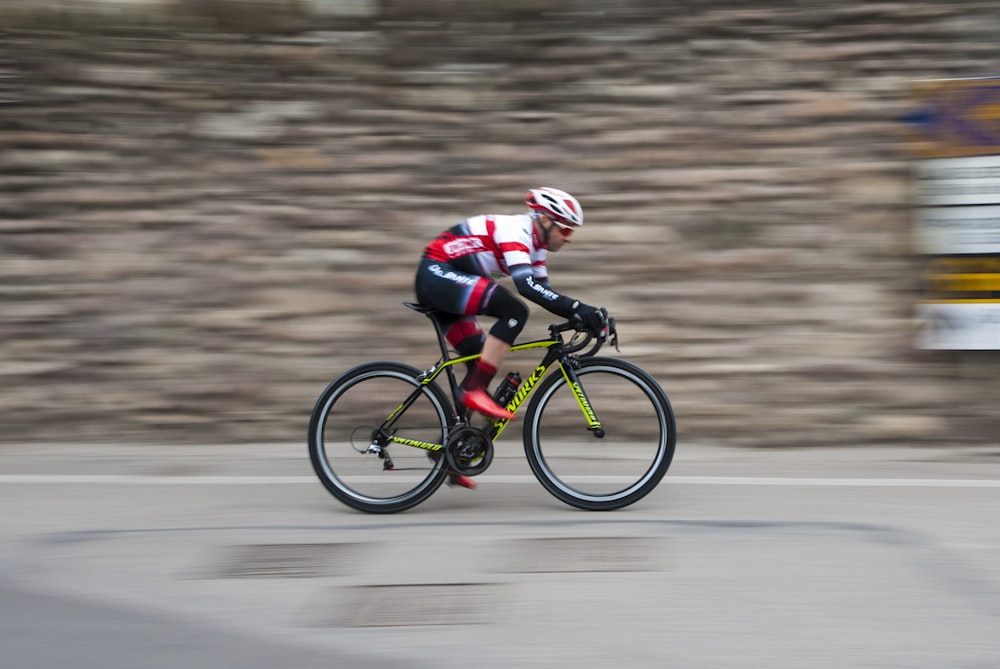Triathlon Bike vs Road Bike: Biggest Differences Explained

Triathlon bikes are a relatively modern innovation in cycling, arriving on the scene late in the 1980s when Ralph Ray and Dan Empfield developed the first model.
The tri bike design allowed riders to achieve the most aerodynamic position possible, reducing drag and increasing the speed you can reach from specific power output. In addition, it helped triathletes utilize different muscle groups. Their overwhelming popularity in triathlons and time trials is a testament to this superiority.
Comparing a triathlon bike vs. road bike is relatively straightforward as it’s just a few modifications that provide most of the difference to their functionality, especially compared to modern aero road bikes.
This article will discuss the strengths and weaknesses of a triathlon vs. road bike, discuss the different components and design features, and answer some of your frequently asked questions.
What Are Triathlon and Road Bikes Used For?
Choosing between a road bike vs. tri bike isn’t complicated. Triathlon bikes are specialized machines for competitive triathletes or time trialists. Road bikes are much more versatile and can do anything on paved roads or light gravel, which is better for the average rider.
Triathlon Bikes
These bikes are for triathlons (and time trial racing), and that’s it. The main differences between tri and road bikes are that each aspect of a tri bike is optimized for aerodynamics and the forward and down rider position that emphasizes the muscle groups not utilized for running (as the running segment of a triathlon race follows the cycle).
The modifications include the tubing shape, steeper frame angles, a higher and more advanced saddle position, and a completely different cockpit. In addition, there are changes to the wheelset, brakes, and gearing, all to reduce drag and create the most aerodynamic rider position.
The benefits that these changes deliver are significant and repeatable. Scientific testing in wind tunnels and other controlled environments has shown the distinct advantages for time-trial or triathlon style riding when routes aren’t too hilly or technical.
However, road bikes are still considered superior for steep climbing and technical riding with many corners. This superiority is because triathlon bikes are heavier and more challenging to handle—the steeper the gradient, the lesser the impact of aerodynamics, and the more weight becomes a factor.
Another downside to tri bikes is that they are more expensive than road bicycles. They’re less adjustable, harder to maintain for beginners, and not very functional outside their domain. In addition, professional riders are raising concerns about the safety of training in the TT position on regular roads due to the limited visibility.
Road Bikes
Road bicycles are made for riding on paved surfaces, regardless of how technical or steep the terrain is. As a result, they are more versatile and comfortable, easier to handle, and lighter than equally-priced triathlon bikes.
Modern road bikes also come in three distinct styles:
- Climbing – These are the light, all-rounder bikes designed to ride fast uphill and perform well in all other aspects of road riding.
- Aerodynamic – The most similar style to a triathlon bike with more aggressive geometry and aerodynamic tubing, slightly heavier than climbing road bikes.
- Endurance – Optimized for comfort over long distances, the endurance road bike is the most versatile in its capabilities. Speed is sacrificed for a more relaxed rider position and extra features like added tire clearance and micro-suspension.
Road bikes benefit from having three distinct and relatively comfortable positions to sit and ride, the tops, drops, and hoods. By making frequent hand position changes, riders can comfortably tackle long days in the saddle, lowering the risk of suffering saddle sores.
In addition to the handlebars, slacker geometry and upright positioning also make handling easier for technical descending or tight corners. Finally, road bikes are cheaper than tri bikes and easier to maintain and adjust as well.
Triathlon Bike vs. Road Bike: Main Differences
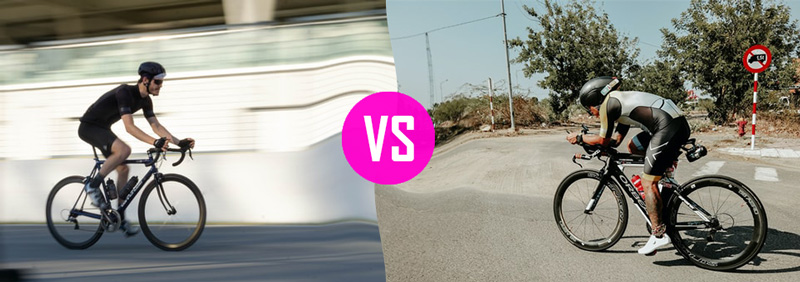
Comparing triathlon bikes vs. road bikes is best done by breaking down the individual components and design characteristics. The science behind each aspect of aerodynamics is quite complex, so we will only provide the basics here.
There isn’t a big difference among triathlon bikes. The optimal design is reasonably well established, with slight improvements made over time. Conversely, road bikes vary hugely, as we touched on above.
However, we will compare a standard climbing road bike to a tri bike for this section.
Frame Design
Tubing on a triathlon frame is fully optimized for aerodynamic advantage to the point of adding weight to do so. The tubing is very easy to identify with its slender, elongated profile. This shape reduces drag by allowing the air to flow freely over it. In addition to tubing, each of the components on a tri bike integrates seamlessly to reduce drag further.
On the other hand, standard road bikes have much less dramatic tubing and less aggressive integration, usually with a circular profile or a slight aero shaping. In addition, climbing frames focus on low weight and stiffness to ensure optimal performance in various road-riding scenarios.
Geometry
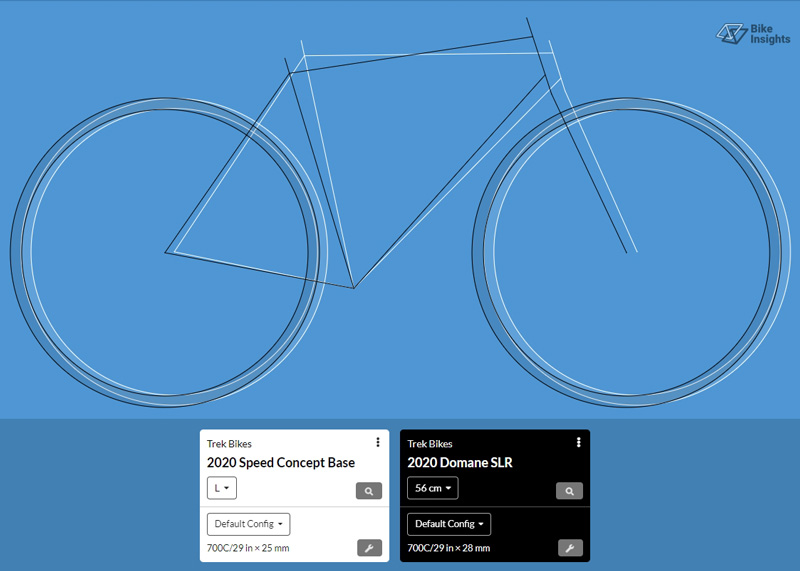
Tri bike (white) vs. road bike (black) geometry compared. | Source: bikeinsights.com
Triathlon geometry is completely different from road geometry, even though it doesn’t look drastically different. The most distinct differences in geometry include a steeper seat angle, shorter and lower headtube, a longer wheelbase and reach. Additionally, the saddle position is more advanced, set above the bottom bracket to take pressure off the hips and hamstrings.
The above changes to standard road bike geometry allow riders to assume a more aggressive position. The torso is forward and low down, parallel to the ground, significantly reducing drag.
Unfortunately, this position is uncomfortable over long-distance rides like centuries, and it creates issues with visibility and requires switching hand position to the bullhorns for cornering.
Road bike geometry is much more versatile. It facilitates quick and easy movement between different positions, comfortably riding out of the saddle, and much greater control over the bike when navigating technical terrain. The angles are slacker, and the positioning is more upright to achieve this.
Brakes
Both road bikes and triathlon bicycles come in rim and disc brake options. The issue with triathlon rim brakes is that they don’t work as well as the traditional v-brake design. The rim brake mechanism is integrated into the frame to improve aerodynamics, resulting in less control and power.
On the other hand, disc brakes work the same on both bike styles. Although they create some extra aerodynamic drag, the improved braking power and modulation will allow you to ride safely at higher speeds, especially in wet weather, as you know your brakes will always perform.
Additionally, rim brakes don’t function as well on carbon rims, and they increase wheel wear, unlike disc brakes which do not cause rim deterioration.
Handlebars
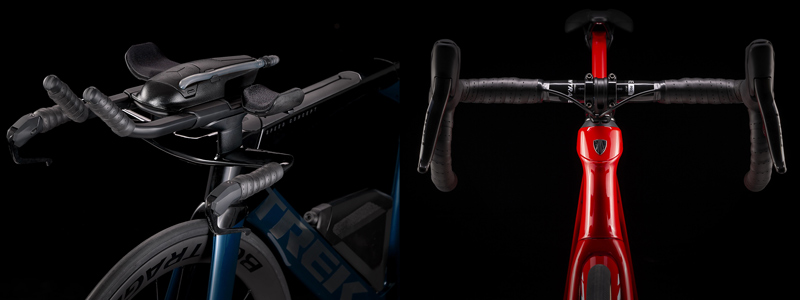
Image source: trekbikes.com
The cockpit of a tri bike is the most distinguishing characteristic. While we are all familiar with road bike handlebars and their hoods and drops, a triathlon bike uses a set of bullhorn bars on the base and aero bar extensions with elbow pads on the top.
You have the shifters at the end of the extensions, as this is the position you use most. The brakes, and sometimes a second set of shifters, called electronic satellite shifters, are fixed to the bullhorns. The adjustable parts of a triathlon cockpit are the pads and extensions, which many riders will continuously adjust in the hunt for the perfect position.
You can attach clip-on extensions to road bikes, allowing you to achieve a similar position to a dedicated triathlon bike without some of the other downsides. For example, the performance gap between a tri bike vs. a road bike with aero bars is far smaller. Pair clip-on extensions with an aerodynamic frame design, and you are most of the way to the real thing.
Wheels

A rear TT disc wheel greatly improves aerodynamics.
Wheels for tri bikes aren’t much different from the high-end wheels used in the pro peloton. However, the rims are generally deeper to improve aerodynamics, usually between 50 and 85mm. In addition, lots of triathletes will use a rear disc wheel when conditions are suitable. This solid disc without spokes eliminates enough drag to justify the added weight.
Tires
Triathlon riders tend to favor 25mm tires at the widest. This width balances rolling resistance and roll-over. Conversely, roadies use 25mm or larger. The extra width of a 28mm tire (commonly used on road bikes) adds comfort and the ability to maintain momentum on bumpier roads through improved shock absorption without a notable addition of rolling resistance.
Gearing
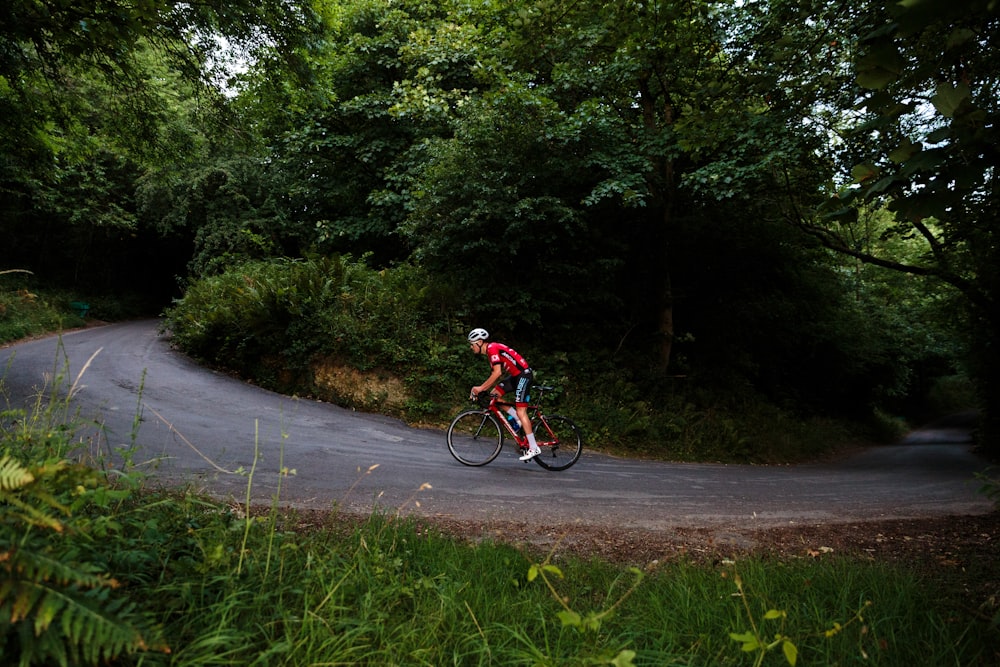
Road bikes typically have a wider gear range in order to facilitate climbing.
As mentioned above, triathlon bicycles use one or two sets of shifters, the primary set located at the end of the extensions and the second set, if used, are on the bullhorns. Road bike shifters operate similarly, using levers (and sometimes buttons) connected to the hoods of the handlebars.
Most triathlon setups include double chainring drivetrains to help with any climbing and reduce the jump between gears. However, some riders favor a 1x drivetrain on super flat courses to minimize weight, drag, and mechanical complexity.
Road bikes usually have wider gear ranges as they are designed to climb, descend, and be fast on flat sections.
The gearing on a triathlon bike vs. road bike is quite similar. Most triathlon riders choose a 53/39t standard chainset, as the courses are predominantly flat. However, riders may switch to a semi-compact (52/36t) or compact (50/34t) chainset for routes with more elevation gain. Likewise, high-level triathletes riding pancake-flat courses may choose an even larger chainring from 54t up to 60t to avoid spinning out at high speeds.
The cassettes on tri bikes also vary but are similar to standard road bikes, although competitive triathletes should change their setup based on the course. For example, an 11-25t cassette is acceptable for flat routes, with the added advantage of smaller jumps between the gears. On the other hand, cassettes for hilly courses have more extensive ranges, such as 11-28t or 11-30t. Thankfully, switching the chainrings and cassettes on the same bike is possible.
Can You Turn a Road Bike into a Triathlon Bike & Vice Versa?
If you want to ride your road bike for triathlon races, it’s relatively easy to mimic a triathlon bike with a few simple changes that bring many of the benefits. Likewise, you can make a couple of tweaks to your triathlon bike to make it more road-ready, although this direction is ineffective and costly.
Road to Triathlon

By adding aero bars to your road bike, you can mimic the aerodynamic position offered by tri bikes.
You can make four changes for a road to triathlon conversion that will completely transform your aerodynamics and create a much more efficient position. Additionally, if you can choose an aero road bike from the outset, these are much closer to the tri bike design.
- Clip-on aero bar extensions allow you to get into a much more aggressive and sustainable position than the drops.
- Swap the seatpost for a steeper model to put the saddle forward over the bottom bracket.
- Raise the saddle and move it forward along the rails to facilitate getting down onto the aero bars.
- Lower the stem as much as possible by removing spacers.
Triathlon to Road
The conversion from triathlon to road is more complicated, expensive, and less effective. In addition, most tri bicycles are very specialized and wouldn’t function well as road bikes. Therefore, if you already own a triathlon bike and no longer need it, it would be better to buy a separate road bike or sell the tri bike to buy a road bike.
However, the same process would apply if you were to attempt the conversion.
- Change the cockpit to a road setup, including regular drop bars with a shorter stem to create an upright position. This change would require rewiring the shifters and brake levers, which would be costly if it were possible.
- If compatible, swap the seatpost for a slacker model.
- Set the saddle lower and further back.
FAQ
Is a tri bike faster than a road bike?
Can I use a tri bike as a road bike?
Are tri bikes worth it?
Is a road bike good for triathlons?
Should I train on a tri bike?
Are triathlon bikes hard to ride?
Are triathlon bikes good for long-distance?
How long does it take to get used to a tri bike?
Do triathlon bikes have brakes?


